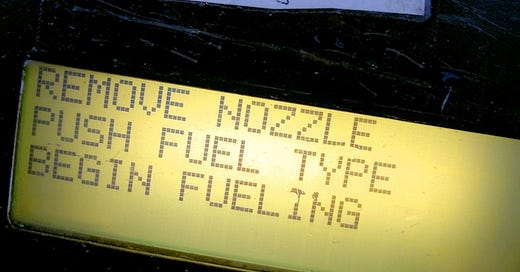In this episode, we explore how technologies and solutions can clash, and what to do about such clashes…
It’s the ‘small stories’ all around that often help us to highlight hidden assumptions and expectations - the kind of assumptions and expectations that can bring a system to a grinding halt. That’s one reason to keep an eye out for those ‘small stories’, and the useful insights that can arise from looking at the content of those stories in a different way.
A good example of this came up for me a few years back, whilst working on yet another presentation for yet another conference. I’d been looking online for suitable images to include in the slidedeck, and in amongst the search-results I came across this photograph:
The yellowish light in the lower part of the picture is the running display for a petrol-pump, a gas-pump or whatever else it might be called in your own locale. One of those things that puts fuel into your car, anyway. It’s displaying the usual overly-terse instructions that you’d expect to see before you start to pump fuel: “Remove nozzle. Push fuel type. Begin fueling.”
And above that display, someone’s taped on a small handwritten message: “If you can’t see the screen, remove sunglasses.”
Huh? What’s that about? How would that help?
Short-answer: it’s a clash of technologies. Or rather, two different uses of the same technology - and it’s those different usages that cause that clash. And whilst the message doesn’t and can’t resolve the clash as such - in the sense of making sure that the clash doesn’t happen again - it does show a practical workaround for the immediate consequences of the clash, enough to get the current job done.
So what’s the technology? What’s the clash?
Short-answer: polarised light. That type of LCD display switches polarisation of the backlight to show the letters on the screen. The ‘black’ colour shows wherever the display-controller has polarised that part of the substrate to block the light from passing through. It’s simple, straightforward, fast, precise, and energy-efficient too: exactly what’s needed on something like a status-display for a fuel pump that’ll be out in all weathers, dealing with extremes of heat and cold and the rest.
But to succeed in its aims, it depends on being the only thing in that context that’s changing the polarisation. Which, unfortunately, won’t be the case if the customer is wearing polarised sunglasses. And the most common polarisation used in sunglasses is set up to cut back on any horizontal reflections - which happens to be the same polarisation that the LCD-display uses for ‘black’. The result is that if you’re wearing sunglasses, it’s likely that the LCD screen will seem to be a solid black (or in some cases, an empty blank), with no text visible at all.
Oops…
As that handwritten message says, there’s a straightforward workaround: take off your sunglasses. Not a big deal, but definitely an annoyance.
Bah.
Note that this isn’t anyone’s fault as such: it’s just ‘one of those things’ that happens when otherwise-good solutions from different domains happen to collide within the larger scheme of things. Yet notice also that in this case, as usual, it’s the human side that has to adapt, to make the overall service work: the machine itself can’t make any change in what it does.
Oh well.
Or, at least, it’s assumed to not be the designer’s fault, on either side of that equation. Yet actually, there are ways to pre-empt that kind of clash. And foremost amongst those is proper practice of whole-enterprise architecture, whole-enterprise design: exploring impacts and implications across the whole of the context, rather than solely of our own immediate part, from our own perspective alone.
It’s probably unfair to say that the respective designers ‘should’ have known that this kind of clash would arise; but it usually is fair to say that they could have known about that risk. Better awareness of the context could lead to small changes - such as a properly printed label on the fuel-pump, rather than relying on some staffer at the fuel-station to fix up a hand-written note, after too many complaints that ‘the display doesn’t work’ when it actually does.
And it’s worthwhile looking around at our own contexts for similar examples, and similar small changes that we could make, to make everyone’s life just that little bit better in that context. Any comments on your experiences of this that you’d like to share with others, perhaps?




Additional Note : If after removing your sunglasses you still cannot see display, visit an optician.